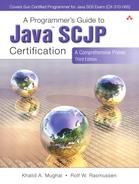List of Figures
1.4 Class Diagram Showing Static Members of a Class
1.6 Class Diagram Depicting Inheritance Relationship
1.7 Class Diagram Depicting Aggregation
2.1 Primitive Data Types in Java
3.3 Parameter Passing: Primitive Data Values
3.4 Parameter Passing: Reference Values
4.1 Java Source File Structure
5.1 Widening Primitive Conversions
5.2 Overflow and Underflow in Floating-point Arithmetic
5.3 Numeric Promotion in Arithmetic Expressions
6.1 Activity Diagram for if Statements
6.2 Activity Diagram for a switch Statement
6.3 Activity Diagram for the while Statement
6.4 Activity Diagram for the do-while Statement
6.5 Activity Diagram for the for Statement
6.9 Partial Exception Inheritance Hierarchy
6.10 The try-catch-finally Construct
6.11 Exception Handling (Scenario 1)
6.12 Exception Handling (Scenario 2)
6.13 Exception Handling (Scenario 3)
6.14 Execution of the Simple assert Statement (with Assertions Enabled)
7.3 Reference Type Hierarchy: Arrays and Subtype Covariance
7.4 Type Hierarchy to Illustrate Polymorphism
7.5 Implementing Data Structures by Inheritance and Aggregation
8.1 Static Member Classes and Interfaces
8.2 Outer Object with Associated Inner Objects
8.3 Nested Classes and Inheritance
8.4 Local Classes and Inheritance Hierarchy
9.1 Memory Organization at Runtime
10.1 Partial Inheritance Hierarchy in the java.lang Package
10.2 Converting Values Between Primitive, Wrapper, and String Types
11.1 Partial Byte Stream Inheritance Hierarchies
11.2 Stream Chaining for Reading and Writing Binary Values to a File
11.3 Partial Character Stream Inheritance Hierarchies
11.4 Setting up a PrintWriter to Write to a File
11.5 Setting up Readers to read Characters
11.8 Keyboard and Display as Console
13.1 Spawning Threads Using a Runnable Object
13.2 Spawning Threads—Extending the Thread Class
14.2 No Subtype Covariance for Parameterized Types
14.4 Partial Type Hierarchy for Node<? super Integer>
14.3 Partial Type Hierarchy for Node<? extends Number>
14.5 Partial Type Hierarchy for Selected Parameterized Types of Node<E>
14.6 Flexible Comparisons with Wildcards
15.2 The Core Collection Interfaces and Their Implementations
15.3 The Core Map Interfaces and Their Implementations
